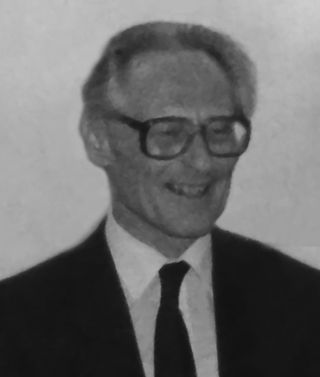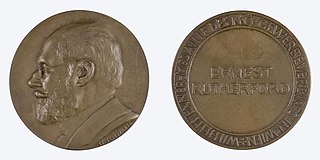
Manfred Eigen was a German biophysical chemist who won the 1967 Nobel Prize in Chemistry for work on measuring fast chemical reactions.

Richard Johann Kuhn was an Austrian-German biochemist who was awarded the Nobel Prize in Chemistry in 1938 "for his work on carotenoids and vitamins".

Sir Alan Roy Fersht is a British chemist at the MRC Laboratory of Molecular Biology, Cambridge, and an Emeritus Professor in the Department of Chemistry at the University of Cambridge. He was Master of Gonville and Caius College, Cambridge from 2012 to 2018. He works on protein folding, and is sometimes described as a founder of protein engineering.

Werner Kutzelnigg was a prominent Austrian-born theoretical chemist and professor in the Chemistry Faculty, Ruhr-Universität Bochum, Germany. Kutzelnigg was born in Vienna. His most significant contributions were in the following fields: relativistic quantum chemistry, coupled cluster methods, theoretical calculation of NMR chemical shifts, explicitly correlated wavefunctions. He was a member of the International Academy of Quantum Molecular Science.

Charles Weissmann is a Hungarian-Swiss molecular biologist. Weissmann is particularly known for the first cloning and expression of interferon and his contributions to the unraveling of the molecular genetics of neurogenerative prion diseases such as scrapie, Creutzfeldt–Jakob disease and "mad cow disease".

Edmund Hlawka was an Austrian mathematician. He was a leading number theorist. Hlawka did most of his work at the Vienna University of Technology. He was also a visiting professor at Princeton University and the Sorbonne. Hlawka died on 19 February 2009 in Vienna.

Hans Tuppy was an Austrian biochemist who participated in the sequencing of insulin, and became Austria's first university professor for biochemistry. He was Austrian Minister for Science and Research from 1987 to 1989.

Franz Serafin Exner was an Austrian physicist and professor at the University of Vienna. He is known for pioneering physical chemistry education in Austria. The early introduction to university curricula of subjects such as radioactivity, spectroscopy, electrochemistry electricity in the atmosphere, and color theory in Austria are often credited to him.

Meir Wilchek is an Israeli biochemist. He is a professor at the Weizmann Institute of Science.

Günther Wilke was a German chemist who was influential in organometallic chemistry. He was the director of the Max Planck Institute for Coal Research from 1967–1992, succeeding Karl Ziegler in that post. During Wilke's era, the MPI made several discoveries and achieved some financial independence from patents and a gift from the Ziegler family. The institute continued as a center of excellence in organometallic chemistry.

Karl Schlögl was professor of organic chemistry at the University of Vienna and secretary as well as vice-president of the Austrian Academy of Sciences.

Michael Grätzel is a professor at the École Polytechnique Fédérale de Lausanne where he directs the Laboratory of Photonics and Interfaces. He pioneered research on energy and electron transfer reactions in mesoscopic-materials and their optoelectronic applications. He co-invented with Brian O'Regan the Grätzel cell in 1988.
Helmut Zahn was a German chemist who is often credited as the first to synthesize Insulin in 1963. His results synthesizing insulin were achieved almost simultaneously with that of Panayotis Katsoyannis at the University of Pittsburgh. His work was not honoured by the Nobel prize because in 1958 Frederick Sanger was the first who discovered the chemical structure of Insulin.

Karl Kordesch was an Austrian chemist and inventor, most notable for jointly inventing the alkaline battery. In 1953 he moved to the United States as part of Operation Paperclip.
Helmut Schwarz is a German organic chemist. He has been a professor of chemistry at the Technische Universität Berlin since 1978. In 2018, he was elected a foreign associate of the U.S. National Academy of Sciences.
Otto Kratky was an Austrian physicist. He is best known for his contribution to the small-angle X-ray scattering method, for the Kratky plot, and for the invention of the density metering using the oscillating u-tube principle. The worm-like chain model in polymer physics, introduced with Günther Porod in a 1949 paper, is also named the Kratky–Porod model.

The Wilhelm Exner Medal has been awarded by the Austrian Industry Association, Österreichischer Gewerbeverein (ÖGV), for excellence in research and science since 1921.
Otto Hittmair (1924–2003) was an Austrian theoretical physicist who made contributions to quantum mechanics, superconductivity and unified field theory. From 1987 to 1991 he was President of the Austrian Academy of Sciences.

John S. McCaskill is an Australian chemist who works in a wide variety of fields ranging from theoretical biochemistry to novel computation to artificial life.
Stefan Grimme, is a German physical chemist. He completed a Ph.D. thesis on photochemistry at Technical University of Braunschweig in 1991, and has been a professor at the Universität Bonn since 2011. Grimme is active in the field of computational chemistry and was elected a member of the Academy of Sciences Leopoldina in 2018.














